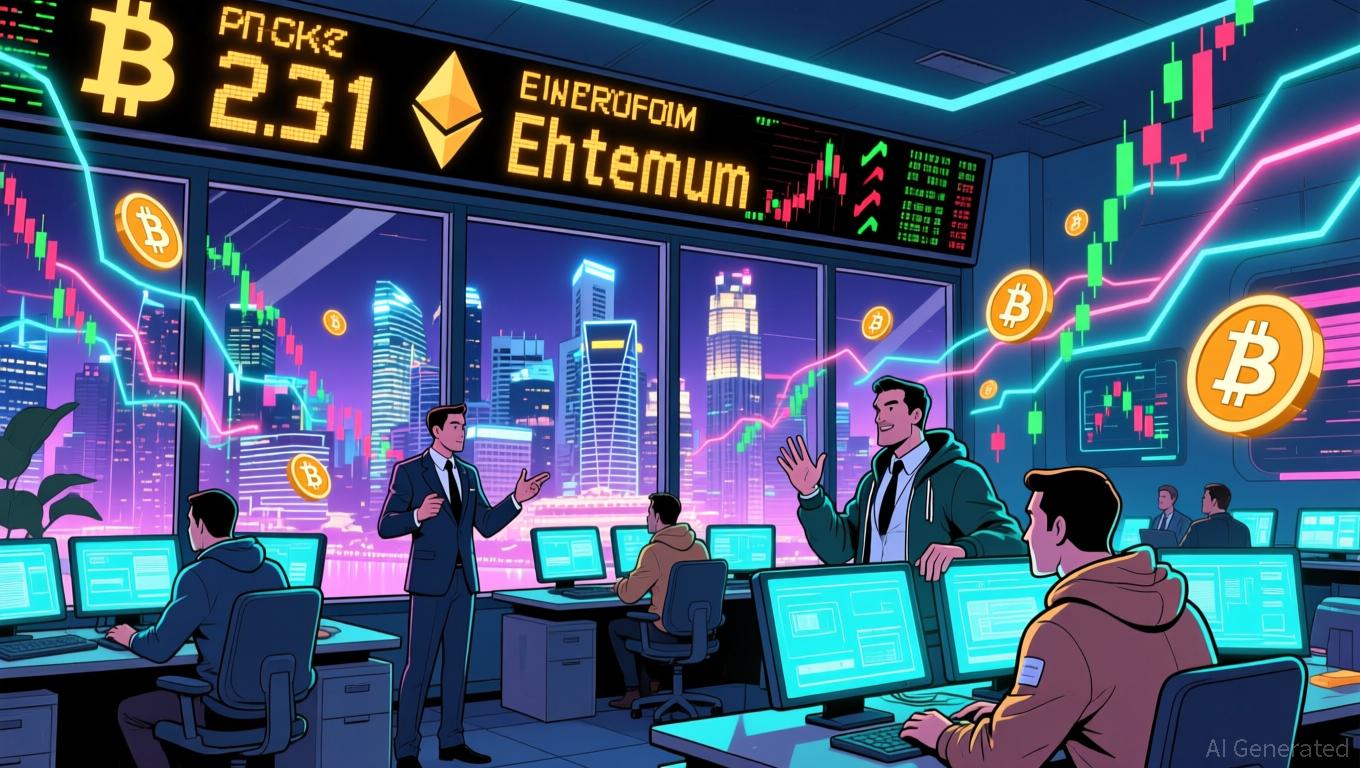Bitcoin News Update: Exchanges Compete With Crypto Perpetuals to Regain Importance Among Institutions
- Stock exchanges like SGX and Qatar bourses face pressure to adopt crypto perpetual futures (perps) to retain institutional relevance amid $187B+ global daily trading volumes. - SGX's Nov. 24 Bitcoin/Ethereum perps launch reflects traditional finance's integration with crypto, as $57.7B+ daily Bitcoin perp volumes outpace traditional offerings. - Gulf markets show mixed adaptation: Qatar's Ooredoo QPSC secondary offering contrasts with UAE's $5B+ in 2024 secondary sales, while China's property crisis expo
Stock Exchanges Face Transformation Amid Surge in Perpetual Futures
The rapid growth of equity perpetual futures is pushing stock exchanges worldwide to a critical juncture. Leading platforms such as the Singapore Exchange (SGX) and Qatar's exchanges are under pressure to evolve or risk falling behind. SGX’s recent introduction of Bitcoin and Ethereum perpetual futures—among the first of their kind in Asia—highlights the growing influence of crypto-based products, which are increasingly outpacing conventional financial instruments.
Globally, perpetual contracts now account for over $187 billion in daily trading volume, prompting exchanges to swiftly incorporate these offerings to maintain their appeal to institutional investors. The SGX’s move, which began on November 24, is part of a broader initiative to merge traditional finance with the digital asset ecosystem. Perpetual futures, which have no set expiration and rely on funding rates to align with spot prices, have become a dominant force in crypto trading since late 2020. For example, Bitcoin perpetuals alone averaged $57.7 billion in daily trades in early 2024. This strategy is a key element of SGX’s $5 billion Equity Market Development Programme, designed to rejuvenate Singapore’s exchange and signal that regulated crypto derivatives are now accessible to major investors.

The timing of these developments is notable: Bitcoin recently experienced a sharp decline, erasing its 2025 gains and dropping below $90,000 after previously reaching a high of $126,251. Despite this downturn, Hassan Ahmed, head of Coinbase Singapore, believes that launching perpetual futures during a market correction encourages institutions to view them as tools for managing risk, rather than simply speculative assets.
Traditional Markets Respond to Change
Other exchanges are also feeling the need to adapt. In Qatar, a $552 million secondary share sale by Ooredoo QPSC marked the most significant equity market activity in years. Analysts at Citigroup suggest this could pave the way for more listings as Qatar seeks to expand market participation. Regulatory changes—such as permitting short-selling and offering incentives for companies to relocate—are intended to enhance liquidity, though ongoing progress will depend on continued offerings and the emergence of local market leaders. Meanwhile, the UAE has already generated nearly $5 billion from secondary share sales this year, underscoring the urgency for other exchanges to innovate.
Risks and Challenges in Evolving Markets
However, the path to modernization carries risks. Private equity firms like Gaw Capital Partners, which recently secured an 18-month loan extension for a Shanghai property-backed asset (with the loan reduced to $108 million), illustrate the vulnerability of traditional investment approaches amid China’s real estate turmoil. Additionally, high-profile setbacks—such as Platinum Equity’s $1.4 billion loss on United Site Services—highlight the dangers of excessive reliance on leveraged buyouts. These examples reinforce a broader trend: as financial markets transform, inflexible business models are increasingly at risk.
The Future of Perpetual Futures
The influence of equity perpetuals is likely to expand beyond the crypto sector. Architect Financial Technologies has recently launched perpetual futures for mainstream assets like foreign currencies and stock indices, hinting at a significant shift in market dynamics. Crypto exchange Hyperliquid is also broadening its offerings, introducing new incentives for perpetual markets that include tokenized equities and pre-IPO stocks. For stock exchanges, the imperative is clear: ongoing innovation is essential for survival.
As Hassan Ahmed observed, “The key benefit of launching during a downturn is that institutions get to see the value of perps as genuine risk-management tools rather than speculative instruments.”
In an environment where Bitcoin’s price swings rival those of major stock indices and regulatory frameworks are in flux, the ability to adapt may prove to be the most valuable asset for exchanges moving forward.
Disclaimer: The content of this article solely reflects the author's opinion and does not represent the platform in any capacity. This article is not intended to serve as a reference for making investment decisions.
You may also like
XRP News Today: XRP ETF Momentum Contrasts with Declining Network Engagement
- XRP's ETF inflows exceed $420M daily, contrasting with 50% lower on-chain payment volume and declining transaction counts. - Technical indicators show fragile bullish momentum below $2.28, while RSI rejection and EMA positioning highlight bearish pressure. - Fed's 81% rate cut probability and ETF-driven demand could push XRP toward $3, but network activity weakness raises sustainability doubts. - MACD buy signals clash with declining 50-day EMA ($2.38) and structural vulnerabilities in ETF-dependent pric

Ethereum News Update: North Korean Cybercriminals' Cross-Chain Money Laundering Reveals Vulnerabilities in Crypto Security
- North Korean hackers suspected in $36.8M Upbit breach used multi-chain laundering across Solana and Ethereum to obscure stolen assets. - Upbit froze transactions, pledged user reimbursements, and faces regulatory fines for delayed reporting amid a $10.3B merger with Naver. - Attack mirrors 2019 Lazarus tactics, exposing crypto industry vulnerabilities as stolen funds were rapidly converted into $1.6M via 185 wallets. - Market volatility surged with altcoin price spikes, while regulators intensify scrutin

Blazpay's 24-Hour Timer: AI-Powered Token Set to Dominate the 2025 Cryptocurrency Surge
- Blazpay's Phase 4 presale enters final 24 hours with $1.52M raised and 78.6% tokens sold, outpacing initial sales projections. - Analysts highlight 3.4x-5x return potential for early buyers, citing AI-powered trading tools, multichain infrastructure, and audit-backed security protocols. - Investors can purchase BLAZ tokens via USDT/ETH/BNB through the official portal, with referral incentives and gamified rewards boosting community engagement. - Project emphasizes real-world utility including automated t

Bitcoin News Update: MSCI Regulation Ignites Tension Between Bitcoin and Major Traditional Financial Institutions
- MSCI's proposed rule to exclude firms with over 50% crypto assets risks triggering $8.8B in forced Bitcoin sell-offs from index-tracking funds by 2026. - JPMorgan's analysis highlights existential threats for crypto-focused companies like Strategy (MSTR), which could face $2.8B in passive outflows alone. - Critics accuse MSCI and JPMorgan of bias, citing the bank's anti-crypto stance and the "binary cliff effect" of the 50% threshold destabilizing market eligibility. - The debate reflects a clash between
